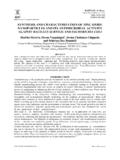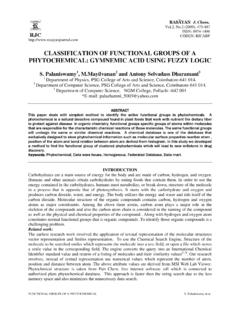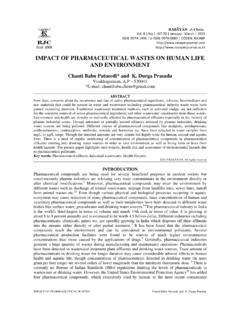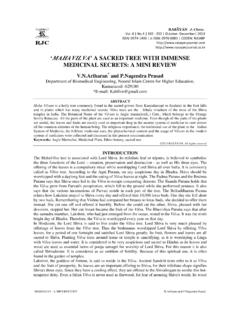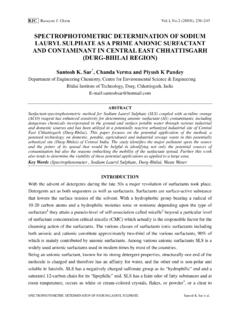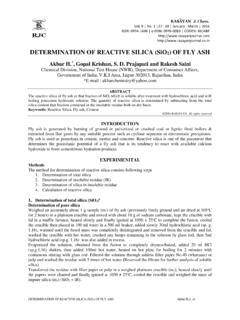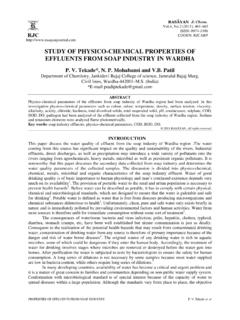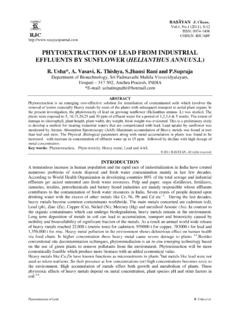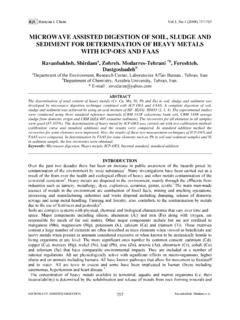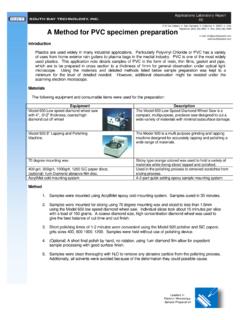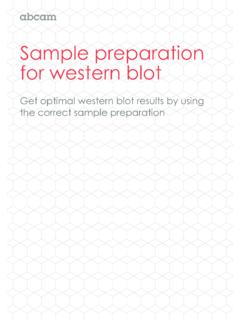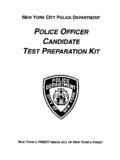Transcription of SAMPLE PREPARATION FOR FLAME ATOMIC …
1 , (2011), 49-55. ISSN: 0974-1496. CODEN: RJCABP. SAMPLE PREPARATION FOR FLAME ATOMIC . ABSORPTION SPECTROSCOPY: AN OVERVIEW. Nabil Ramadan Bader Chemistry department, Faculty of science, Garyounis university, Benghazi, Libya. E-mail: ABSTRACT. SAMPLE PREPARATION is an important step in chemical analysis, from time and reagent consuming point of view and from the probability of errors. The present article gives an overview of recently most used techniques in SAMPLE PREPARATION for FLAME ATOMIC absorption spectroscopy. Wet and dry SAMPLE decomposition techniques, separation and pre-concentration methods of the target analyte(s) have been discussed. Keywords: SAMPLE PREPARATION , FAAS, decomposition, separation, pre-concentration 2011 RAS YAN. All rights reserved. INTRODUCTION. Elemental analysis of the majority of organic and inorganic matrices requires the partial or total dissolution of the SAMPLE prior to instrumental analysis.
2 Analysis by spectroscopic methods practically always necessitates a simple or more complex PREPARATION of the SAMPLE . These steps are generally the most critical part of analysis because they are responsible for the most important Only a few direct methods allow the introduction of the SAMPLE without any PREPARATION . In these cases the lack of reliable calibration is the major problem. On the other hand, SAMPLE PREPARATION allows the separation and/or pre-concentration of analytes and makes possible the use of several determination methods. SAMPLE preparations involve digestion, extraction and PREPARATION of the analytes before the analysis, so this step is time limiting, requiring ca. 61% of the total time to perform the complete analysis, and is responsible for 30% of the total analysis error. Nowadays the goals to be reached are the best results, in the shortest time, with minimal contamination, low reagent consumption and generation of minimal residue or waste.
3 1. SAMPLE PREPARATION was probably the single most neglected area in analytical chemistry relatively to the great interest in instruments. While the level of sophistication of the instrumentation for analysis has increased significantly, a comparatively low technical basis of SAMPLE PREPARATION often SAMPLE PREPARATION and development of methods have now became a growing field along with instrumental improvements. There are drastic improvements in the detection power of measurement techniques used. Consequently, the analyst also realizes that it is often no longer mandatory to resort to laborious, dubious and time-consuming separation or pre-concentration steps in the SAMPLE PREPARATION It is normal in ATOMIC spectroscopy for the SAMPLE to be found in one of two forms solid or liquid. The liquid case would seems to be the easiest form in which to handle the SAMPLE , with maybe a requirement for filtration being all that is required.
4 However, the inherent lack of sensitivity of many spectroscopic techniques and the need to carry out determinations at lower and lower levels means that invariably some form of pre-concentrations is required. If the SAMPLE is in a solid form, the normal requirement is to covert it into the liquid form although it is possible to analyse solids directly by using the ATOMIC spectroscopy, but this is not the preferred The principal objectives of SAMPLE PREPARATION for residue analysis are; isolation of the analytes of interest from as many interfering compounds as possible, dissolution of the analytes in a suitable solvent and pre- SAMPLE PREPARATION FOR FAAS Nabil Ramadan Bader , (2011), 49-55. concentration. In an analytical method SAMPLE PREPARATION is followed by a separation and detection procedure.
5 EXPERIMENTAL. The selection of a PREPARATION method is dependent upon: (1) the analyte(s), (2) the analyte concentration level(s), (3) the SAMPLE matrix, (4) the instrumental measurement technique, and (5) the required SAMPLE size. Matrix The term matrix refers to the collection of all of the various constituents making up an analytical SAMPLE . In addition to the analyte, the SAMPLE matrix includes all of the other constituents of the SAMPLE , which are sometimes referred to as concomitants. Contamination and Losses The major problem in preparing samples for trace analysis is the risk of contamination. Contamination is associated with several probable causes, the grade of reagents used, SAMPLE storage container, steps of digestion or dilution of the SAMPLE and their previous history, and human intervention.
6 Losses are a particularly significant problem in trace analysis. Container surfaces, for example, may present a significantly large area on which the analyte can be adsorbed. At higher levels such a small absolute loss would have little effect on the concentration but at trace levels a large proportion of the analyte may be stripped from the samples samples analyzed may be divided into those which are already in an aqueous solution ( various water samples , beverages, blood, serum, and urine.), in other liquid form ( oils, fuels, and organic solvents.). or in solid form ( soils, sediments, plants, animal tissues, metals, and plastics.). Solid samples may contain a high proportion of organic matter ( plants, animal tissues, and plastics.) or have more inorganic composition ( soils, sediments, and metals.)
7 For routine analysis by ATOMIC spectroscopic techniques, which are all dedicated to work with aqueous samples , the analysis of other liquids must be adapted and the solids are generally converted into a solution by an appropriate dissolution Liquid samples Aqueous samples can be generally introduced for analysis directly and without any prior treatment. The only major problem associated with work with solutions is their collection and storage. Concerning ATOMIC spectroscopic analysis itself, no particular precautions have to be taken. If measured concentrations satisfy the principal criteria of the spectroscopic method used (sensitivity, dynamic range). and possible interferences are under control, the analysis of solutions may be performed automatically with all modern ATOMIC spectroscopic systems.
8 Non-aqueous samples can sometimes be run directly, but this depends significantly on their viscosity. In FLAME ATOMIC absorption spectroscopy (FAAS) analysis, the viscosity should be similar to that of water for which most nebulizers are designed. Only some organic solvents, such as ethanol or methyl isobutyl ketone, fulfill this condition and are consequently often used for dilution of organic liquids, the major drawback, encountered with these techniques is the dilution factor, which reduces the metal content per unit Standards can be prepared in the pure solvent. Elements in organic solvents usually give an FAAS analysis response similar to that given by the same element in aqueous solution. Solid samples In this case, many steps are required, including sampling, sub-sampling, grinding, and dissolution.
9 The risk of contamination is higher than the case of liquid samples . RESULTS AND DISCUSSION. SAMPLE PREPARATION techniques A. Decomposition techniques Decomposition involves the libration of the metal of interest from an interfering matrix by using a reagent and/or heat. The utilization of reagents or acids may cause contamination or loss of the analytes. Acid digestion or wet decomposition SAMPLE PREPARATION FOR FAAS 50 Nabil Ramadan Bader , (2011), 49-55. Acid digestion involves the utilization of mineral or oxidizing acids and an external heat source to decompose the SAMPLE matrix. The choice of the acid or the combination of the acids depends upon the nature of the matrix to be decomposed. Wet decomposition has been performed in open systems for many years: Teflon beakers when using HF. or glass tubes or beakers on hot plates or aluminum blocks.
10 Open systems are useful for relatively easy . samples such as food or agricultural, but generally unsuitable for some samples that require lengthy dissolution times of 1 24 h. Other concerns are that they tend to be time consuming and tedious and result in evaporative loss of volatile metals and the risk of In general, nitric acid is used as oxidant alone or in combination with other acids ( , sulfuric and hydrochloric acids) or sometimes with hydrogen In addition, hydrofluoric acid can be used in combination with nitric acid for the total decomposition of silica containing organic Nitric acid is popular because of its chemical compatibility, oxidizing ability, availability, purity, and low For samples that are not highly aromatic and/or contain a high -OH functionality, it is preferred to use nitric acid followed by perchloric acid.
